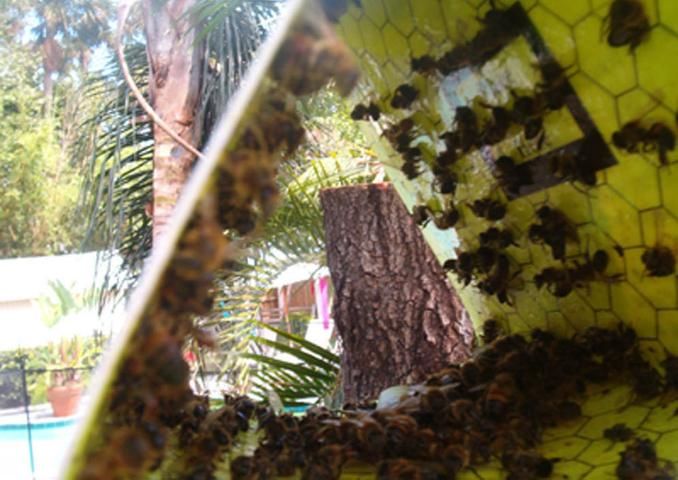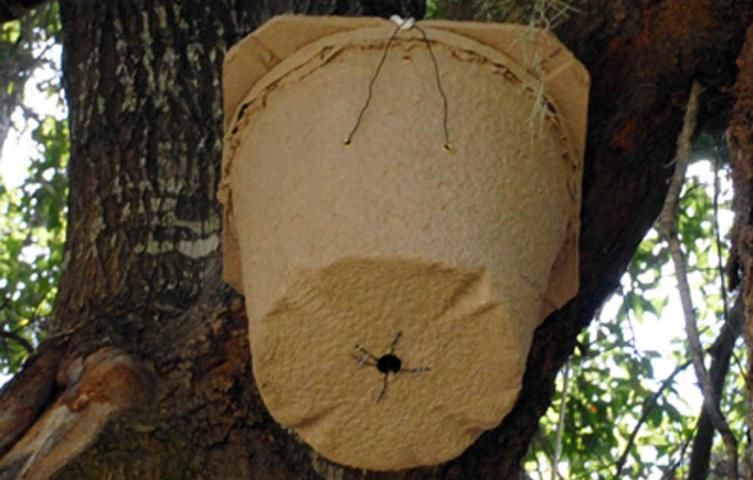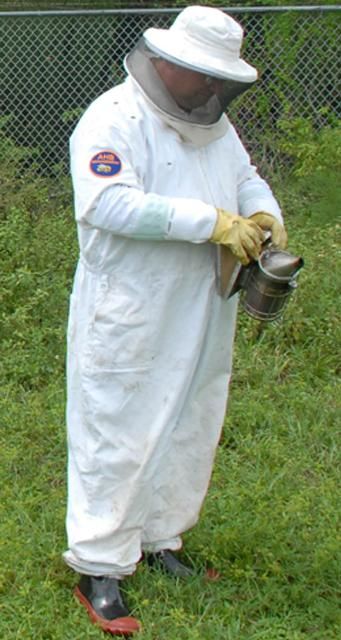The state of Florida recommends that nuisance honey bees (https://edis.ifas.ufl.edu/in1005 and https://edis.ifas.ufl.edu/in790) found nesting outside of hives managed by a beekeeper (like those nesting in tree cavities, walls, water meter boxes, etc.) be either (1) removed from the nest site by a registered beekeeper (www.FDACS.gov/BeeRemoval ) (2) eradicated by a licensed Pest Control Operator. It is the responsibility of the property owner to deal with an unwanted swarm (https://edis.ifas.ufl.edu/in970) or colony of honey bees. To find a registered beekeeper or PCO who offers removal or eradication services, visit: http://entnemdept.ufl.edu/honey-bee/beekeeper-resources/bee-removal/ and click on "Find a Bee Removal Expert in your area". For more information on African honey bees, see https://edis.ifas.ufl.edu/topic_africanized_honey_bee.
What's in a name?
In popular literature, "African," "Africanized," and "Killer" bees are terms that have been used to describe the same honey bee. However, "African bee" or "African honey bee" most correctly refers to Apis mellifera scutellata when it is found outside of its native range. A.m. scutellata is a subspecies or race of honey bee native to sub-Saharan Africa where it is referred to as "Savannah honey bee" given that there are many subspecies of African honey bee, making the term "African honey bee" too ambiguous there. The term "Africanized honey bee" refers to hybrids between A.m. scutella and one or more of the European subspecies of honey bees kept in the Americas. There is remarkably little introgression of European genes into the introduced A.m. scutellata population throughout South America, Central America, and Mexico. Thus, it is more precise to refer to the population of African honey bees present in the Americas as "African-derived honey bees." However, for the sake of simplicity/consistency, we will refer to African-derived honey bees outside of their native range as "African honey bees" or "AHBs".
How to Find a Trained PCO
The Florida Department of Agriculture and Consumer Services (FDACS) maintains a list of PCOs who offer bee removal or eradication services. This list is available at https://www.fdacs.gov/Consumer-Resources/Consumer-Rights-and-Responsibilities/Pest-Control/Honey-Bee-Removal-or-Eradication-in-Florida.
If a homeowner or property owner wishes to contract a PCO, rather than a registered beekeeper who can only provide removal services, and is unsure if the PCO is trained to remove/eradicate honey bee colonies, the homeowner should inquire to ensure that the PCO has been trained in honey bee removal/eradication procedures and that the PCO has experience removing stinging insect colonies.
Customers in need of a PCO should consider entering into an official contract that states the specific terms of the removal. A contract should detail the colony removal procedure, i.e. the method of applying pesticides, disposal of dead bees, and complete removal of comb. Sometimes, a PCO will not remove the comb or inform the customer of the importance of comb removal even if the customer hires the PCO to remove all of the nest contents. In this case, several days after colony eradication, insect larvae [including wax moth larvae (http://entnemdept.ufl.edu/creatures/MISC/BEES/Achroia_grisella.htm) and small hive beetle larvae (https://edis.ifas.ufl.edu/in854)] feeding on the remaining comb can enter the home, or stored honey drip out through an area adjacent the nest, staining the wall or ceiling near it. Without a contract that states specific removal terms, the customer may have no recourse if these events occur.
What to Expect from a PCO
When PCOs are trained to deal with stinging insects and removal of honey bee colonies, they are provided with removal procedures that include details such as what types of pesticides to use and when, the best time to remove a colony, what personal protective equipment to wear, etc. The following list gives some examples of things you should expect a trained PCO to do.
A PCO should:
- Wear personal protective equipment that includes a veil, sting suit and gloves,
- Be able to recognize if the bees on your property are actually honey bees, and if the bees are in a swarm (https://edis.ifas.ufl.edu/in970) or part of an established colony (https://edis.ifas.ufl.edu/in1005) and be able to explain the difference to you,
- Explain that if the bees are honey bees, they could be either African or European because it is impossible to differentiate between the two without laboratory analyses,
- Ensure that the area around the bees is secured from onlookers, pedestrians, or anyone else who may be in proximity to the bee colony during the removal process,
- Ensure that no penned or tied animals are in or near the colony removal area,
- Possess either a General Household Pest (GHP) license that covers indoor and outdoor eradication—or a Lawn & Ornamental license (L&O) that covers exterior eradication,
- Apply only pesticides that are labeled for use on honey bees or labeled for use on the application site (e.g. some pesticides may not specifically mention honey bees on the label, but they may specify use in a wall void or ground cavity),
- Remove from the customer's property all dead bees and all combs associated with the colony, [This is an essential aspect of the removal. If comb is not completely removed, roaches and other insects will be attracted to the rotting brood, fermenting honey may produce an unpleasant odor, and honey/melting wax may soak into the wall causing a stain and rendering that wall impossible to paint or wallpaper.]
- Apply a residual pesticide to help protect against bees returning to the location, [A swarm trap (https://edis.ifas.ufl.edu/in785) or sticky trap may be left in the area for up to one month to intercept any other swarms attracted to that location.]
- Be responsible for checking, maintaining, and removing bees from any swarm trap or sticky trap left at the former nesting site,
- Discuss the removal procedure with the customer before beginning the removal, [This is essential when the colony is located inside a wall or structure. Honey bee colonies established inside a structure and all comb associated with that colony should be removed as soon as possible, and the customer should be aware that a PCO may need to cut into a wall, subfloor, or other area of a structure to effectively perform the removal.] and
- Discuss bee-proofing with customer after completion of colony and comb removal (https://edis.ifas.ufl.edu/in741).

Credit: AllFloridabeeRemoval.com

Credit: UF/IFAS Honey Bee Lab

Credit: UF/IFAS Honey Bee Lab
The following list gives some examples of things you should not expect a trained PCO to do.
A PCO should not:
- Attempt to remove bees without wearing appropriate protective equipment,
- Apply any substance not labeled for honey bees or the specific application site,
- Remove established colonies during the day (unless discussed and agreed upon with the customer), [When colonies are removed during the day, the bees that are out foraging for nectar and pollen on flowers will return to the nest site that evening. This will result in numerous bees flying around the nest site. If a daytime removal is conducted, it is recommended that the PCO leave a swarm trap or sticky trap to intercept returning bees.]
- Indicate that the bees are African bees (or European bees) because it is impossible to differentiate the two without laboratory analyses, or
- Charge more for the eradication of African honey bee colonies as it is impossible to differentiate between African and European bees without performing a series of laboratory tests.
What a Customer Should Know
All Florida residents should be aware of the presence of AHBs in Florida. This awareness should encourage healthy respect and caution of all stinging insects and a realization of the importance of honey bees nationwide. In addition to being aware of the presence of AHBs in the state, it may be helpful for a customer to know some basic biological and behavioral characteristics of this honey bee. Many resources exist to educate Floridians specifically about the African honey bees. Please see the Additional Resources section for more information.
Additional Resources
https://edis.ifas.ufl.edu/topic_africanized_honey_bee
https://www.fdacs.gov/Consumer-Resources/Health-and-Safety/Africanized-Honey-Bees